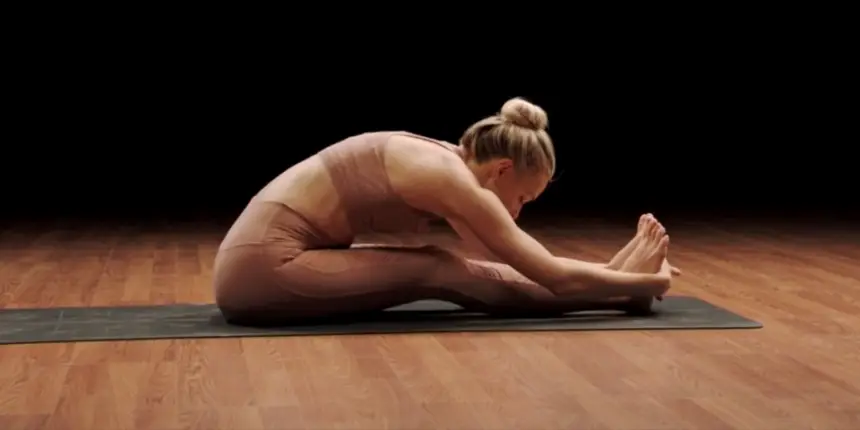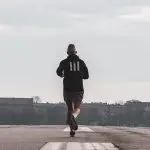As a yoga instructor and naturally versatile individual, folks usually inform me that they do not follow yoga as a result of they are not versatile. However that’s why You follow yoga! One in every of my favourite poses for growing flexibility is the seated ahead bend, additionally recognized by its Sanskrit title. pashimottanasana. (Pronounced PAH-she-moh-ton-AHS-uh-nuh.)
A seated ahead bend could not seem like a lot in a single nonetheless picture. However what you do not see is what impact this stretch has on completely different components of your physique.
“Paskimottanasana It stretches all the bottom of your physique, which is a steady chain of fascia and muscle tissues,” says Stephanie Saunders, BODi’s vice chairman of health programming. So it’s many Greater than only a hamstring stretch.
Learn on to discover ways to grasp this useful fundamental pose.
Sitting ahead bend (Paskimottanasana): Step-by-step directions
- Begin in Employees Pose. Sit tall on the ground together with your legs prolonged in entrance of you, legs bent and toes pointing towards the ceiling. Place your fingers on the ground on or beside your thighs.
- Pull your belly muscle tissues inward, lean ahead utilizing your hips, not your hips, and slowly stroll your fingers out of your ft towards your ft. Keep away from arching your again an excessive amount of or utilizing your arms to pose.
- Relaxation within the pose by grabbing your massive toe, facet of your foot, shin, and ankle as gently as your flexibility permits, holding your backbone impartial.
- Proceed respiration for a minimum of 5 occasions. With every exhale, loosen up, straighten your posture, and stretch deeper.
make ahead bending simpler whereas sitting
Paskimottanasana That is an intense stretch that anybody can do comfortably, even novices. Modifying the seated ahead bend doesn’t scale back its advantages, however relatively makes them extra accessible.
- “You probably have tightness in your hamstrings or hips, you might have to elevate your hips (by sitting on a yoga block or folded blanket) or bend your knees to loosen your hips,” Sanders says. says.
- “You probably have a stiff again, lengthen your backbone and attain earlier than stress-free ahead, utilizing blocks on both facet of your knees to assist your arms, and let gravity do the remainder,” she says.
- You may as well separate your legs in order that your heels are hip-width aside. This will provide you with extra room in your chest and stomach.
strengthen your ahead bend whereas sitting
A seated ahead bend is an intense stretch on your again. You probably have versatile hamstrings and no again ache, it’s doable to strengthen your posture.
- You possibly can strengthen your hamstring stretch by stretching your legs and flexing your toes.
- Deepen the stretch by holding a yoga block in opposition to the soles of your ft.
Newbie suggestions for performing seated ahead bends
Paskimottanasana It isn’t about depth. Many novices suppose that to “obtain” this pose it’s essential preserve your legs straight and produce your nostril nearer to your knees.
In actuality, it is safer and simply as “appropriate” to maintain your backbone impartial and your knees bent. Rounding your backbone in an try to carry your nostril nearer to your knees could cause again ache and strain. As an alternative, concentrate on holding your higher physique on high of your thighs.
Whenever you start practising seated ahead bends, it is necessary to take heed to your physique and breathe. If you cannot preserve your posture after three lengthy breaths, you might be respiration too deep or too quick. Take your time to search out your depth on this pose. Keep, breathe, and deepen.
Advantages of seated ahead bending
Paskimottanasana Though it’s a easy pose, it has varied results.
- Stretch the again of your physique out of your heels to your head
- Helps promote backbone elongation
- Create internal calm by means of respiration
Variations of seated ahead bend
If you happen to’re on the lookout for different kinds of bends that supply a barely completely different stretch, strive a few of these beneath.
1. Standing ahead bend (Uttanasana)
- Begin in your mat in Mountain Pose. Inhale and lift your arms straight up, rotating your triceps ahead. Exhale, bend on the waist and attain in direction of the ground.
- Bend your knees barely, fold your torso over your legs, and prolong your backbone down.
- Place your fingertips or palms on the ground, together with your fingers in step with your toes.
- Have a look at your legs. Spiral your shoulders to the perimeters and away out of your ears.
- Carry the arch of your foot. Stabilize your leg by lifting your kneecap.
- Carry your tailbone towards the ceiling whereas rotating your thighs inward.
- Shift your weight barely ahead in your ft so your hips are over your heels.
- If doable, begin stretching your legs.
2. Pose with narrowed corners (baddha konasana)
- Sit on the ground together with your butt bone straight beneath you. (This manner you will not push your tailbone in.)
- Convey the soles of your ft collectively and fold your knees to the perimeters. Make sure that the outsides of your ft are touching.
- Convey your heels as near your groin as is comfy.
- Place your thumb on the ball of your foot and wrap your remaining fingers across the high of your foot such as you’re holding an open ebook.
- Maintain your again tall and fall ahead with out rounding your again an excessive amount of or rolling your knees ahead. Maintain for a minimum of 5 breaths or as much as 1 minute.
3. Bend your legs ahead whereas sitting (Upavistha Konasana)
- Begin in Employees Pose. Sit tall on the ground together with your legs prolonged in entrance of you, legs bent and toes pointing towards the ceiling. Place your fingers on the ground on or beside your thighs.
- Unfold your legs as broad as doable, bend your ft and level your toes towards the ceiling.
- Watch out to not spherical your again, bend on the waist and slowly stroll your fingers ahead. Press and maintain for 30-60 seconds.









